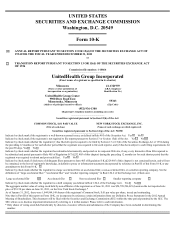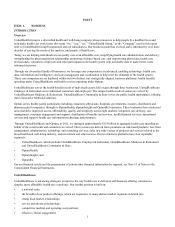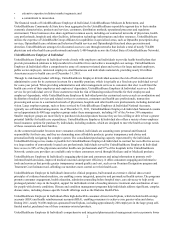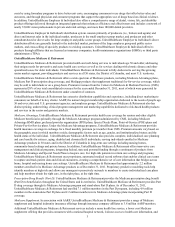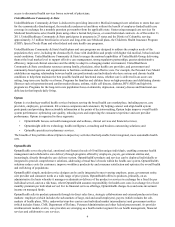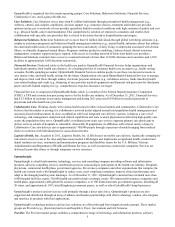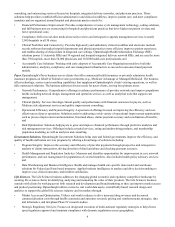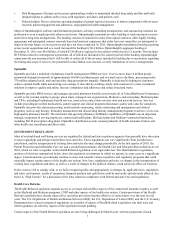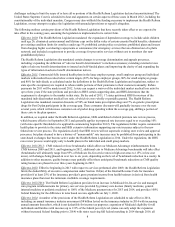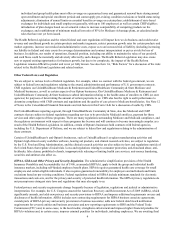United Healthcare 2011 Annual Report Download
Download and view the complete annual report
Please find the complete 2011 United Healthcare annual report below. You can navigate through the pages in the report by either clicking on the pages listed below, or by using the keyword search tool below to find specific information within the annual report.
UNITED STATES
SECURITIES AND EXCHANGE COMMISSION
Washington, D.C. 20549
Form 10-K
ANNUAL REPORT PURSUANT TO SECTION 13 OR 15(d) OF THE SECURITIES EXCHANGE ACT OF
1934 FOR THE FISCAL YEAR ENDED DECEMBER 31, 2011
or
TRANSITION REPORT PURSUANT TO SECTION 13 OR 15(d) OF THE SECURITIES EXCHANGE ACT
OF 1934
Commission file number: 1-10864
__________________________________________________________
UnitedHealth Group Incorporated
(Exact name of registrant as specified in its charter)
Minnesota
(State or other jurisdiction of
incorporation or organization)
UnitedHealth Group Center
9900 Bren Road East
Minnetonka, Minnesota
(Address of principal executive offices)
41-1321939
(I.R.S. Employer
Identification No.)
55343
(Zip Code)
(952) 936-1300
(Registrant’s telephone number, including area code)
__________________________________________________________
Securities registered pursuant to Section 12(b) of the Act:
COMMON STOCK, $.01 PAR VALUE
(Title of each class)
NEW YORK STOCK EXCHANGE, INC.
(Name of each exchange on which registered)
Securities registered pursuant to Section 12(g) of the Act: NONE
__________________________________________________________
Indicate by check mark if the registrant is a well-known seasoned issuer, as defined in Rule 405 of the Securities Act. Yes No
Indicate by check mark if the registrant is not required to file reports pursuant to Section 13 or Section 15(d) of the Act. Yes No
Indicate by check mark whether the registrant (1) has filed all reports required to be filed by Section 13 or 15(d) of the Securities Exchange Act of 1934 during
the preceding 12 months (or for such shorter period that the registrant was required to file such reports), and (2) has been subject to such filing requirements for
the past 90 days. Yes No
Indicate by check mark whether the registrant has submitted electronically and posted on its corporate Web site, if any, every Interactive Data File required to
be submitted and posted pursuant to Rule 405 of Regulation S-T (§232.405 of this chapter) during the preceding 12 months (or for such shorter period that the
registrant was required to submit and post such files). Yes No
Indicate by check mark if disclosure of delinquent filers pursuant to Item 405 of Regulation S-K (§229.405 of this chapter) is not contained herein, and will not
be contained, to the best of registrant's knowledge, in definitive proxy or information statements incorporated by reference in Part III of this Form 10-K or any
amendment to this Form 10-K.
Indicate by check mark whether the registrant is a large accelerated filer, an accelerated filer, a non-accelerated filer, or a smaller reporting company. See the
definitions of “large accelerated filer,” “accelerated filer” and “smaller reporting company” in Rule 12b-2 of the Exchange Act. (Check one)
Large accelerated filer Accelerated filer Non-accelerated filer Smaller reporting company
Indicate by check mark whether the registrant is a shell company (as defined in Rule 12b-2 of the Exchange Act). Yes No
The aggregate market value of voting stock held by non-affiliates of the registrant as of June 30, 2011 was $54,799,296,021 (based on the last reported sale
price of $51.58 per share on June 30, 2011, on the New York Stock Exchange).*
As of January 31, 2012, there were 1,044,964,149 shares of the registrant’s Common Stock, $.01 par value per share, issued and outstanding.
Note that in Part III of this report on Form 10-K, we incorporate by reference certain information from our Definitive Proxy Statement for the 2012 Annual
Meeting of Shareholders. This document will be filed with the Securities and Exchange Commission (SEC) within the time period permitted by the SEC. The
SEC allows us to disclose important information by referring to it in that manner. Please refer to such information.
* Only shares of voting stock held beneficially by directors, executive officers and subsidiaries of the Company have been excluded in determining this
number.
Table of contents
-
Page 1
... of the Exchange Act). Yes No The aggregate market value of voting stock held by non-affiliates of the registrant as of June 30, 2011 was $54,799,296,021 (based on the last reported sale price of $51.58 per share on June 30, 2011, on the New York Stock Exchange).* As of January 31, 2012, there were... -
Page 2
... about Market Risk...Financial Statements and Supplementary Data ...Changes in and Disagreements with Accountants on Accounting and Financial Disclosure...Controls and Procedures ...Other Information ...Part III Directors, Executive Officers and Corporate Governance ...Executive Compensation... -
Page 3
... eight markets: integrated care delivery, care management, consumer engagement and support, distribution of benefits and services, health financial services, operational services and support, health care information technology and pharmacy. Through UnitedHealthcare and Optum, in 2011, we managed... -
Page 4
... management programs help individuals address significant, complex disease states, including disease-specific benefit offerings such as the Diabetes Health Plan. UnitedHealthcare Employer & Individual offers high-deductible consumer-driven benefit plans, which include health savings accounts... -
Page 5
...plans, preferred provider organization (PPO) plans, Special Needs Plans, Point-of-Service (POS) plans and Private-Fee-for-Service plans. Under the Medicare Advantage programs, UnitedHealthcare Medicare & Retirement provides health insurance coverage in exchange for a fixed monthly premium per member... -
Page 6
... the benefit of employer-funded health care coverage in exchange for a monthly premium per member from the applicable state. States using managed care services for Medicaid beneficiaries select health plans using either a formal bid process, or award individual contracts. As of December 31, 2011... -
Page 7
... commercial insurance companies and health plans, approximately 400 global life sciences companies, over 300 federal and state government agencies, including all 50 states, and approximately 150 United Kingdom government payers, as well as other UnitedHealth Group businesses. OptumInsight's products... -
Page 8
... commercial health insurance or privately administer health insurance programs on behalf of federal or state governments (e.g., Medicare Advantage or Managed Medicaid). The business offers technology, services and consulting capabilities that supplement OptumInsight's clients' existing operations... -
Page 9
... value for consumers. OptumRx also provides claims processing, retail network contracting, rebate contracting and management and clinical programs, such as step therapy, formulary management and disease/drug therapy management programs to achieve a low-cost, high-quality pharmacy benefit. The mail... -
Page 10
...premium income from health business is derived from health insurance plans that meet the minimum creditable coverage requirements. Effective 2013/2014: The Health Reform Legislation provides for an increase in Medicaid fee-for-service and managed care program reimbursements for primary care services... -
Page 11
... provisions of the Health Insurance Portability and Accountability Act of 1996, as amended (HIPAA), apply to both the group and individual health insurance markets, including self-funded employee benefit plans. HIPAA requires guaranteed health care coverage for small employers and certain eligible... -
Page 12
..., administration and performance of state government contracts. Guaranty Fund Assessments. Under state guaranty fund laws, certain insurance companies (and HMOs in some states), including those issuing health, long-term care, life and accident insurance policies, doing business in those states can... -
Page 13
... to consumers and care providers. Additionally, different approaches to state privacy and insurance regulation and varying enforcement philosophies in the different states may materially and adversely affect our ability to standardize our products and services across state lines. See Item 1A, "Risk... -
Page 14
...highly competitive markets. Our competitors include managed health care companies, insurance companies, HMOs, TPAs and business services outsourcing companies, health care professionals that have formed networks to directly contract with employers or with CMS, specialty benefit providers, government... -
Page 15
... Services Inc., including President and Chief Executive Officer of AARP Services Inc., Chief Operating Officer of AARP Services Inc., President and Chief Executive Officer of AARP Financial and President of the AARP Funds. Ms. Sweere is Executive Vice President of Human Capital of UnitedHealth Group... -
Page 16
... provider contracts and care management programs. Total medical costs are affected by the number of individual services rendered and the cost of each service. Our premium revenue on commercial policies is typically at a fixed rate per individual served for a 12-month period and is generally priced... -
Page 17
... our revenues, results of operations, financial position and cash flows. Under state guaranty fund laws, certain insurance companies (and HMOs in some states), including those issuing health (which includes long-term care), life and accident insurance policies, doing business in those states can... -
Page 18
... our market share, revenues, results of operations, financial position and cash flows could be materially and adversely affected. In addition, the Health Reform Legislation requires the establishment of state-based health insurance exchanges for individuals and small employers by 2014. The types of... -
Page 19
... that could materially and adversely affect our revenues, results of operations, financial position and cash flows. We participate in various federal, state and local government health care coverage programs, including as a payer in Medicare Advantage, Medicare Part D, various Medicaid programs and... -
Page 20
... Medicare Part D plans only, based on comparing costs predicted in our annual bids to actual prescription drug costs. Some state Medicaid programs utilize a similar process. For example, our UnitedHealthcare Medicare & Retirement and UnitedHealthcare Community & State businesses submit information... -
Page 21
... control could affect our ability to timely process and dispense prescriptions and could materially and adversely affect our results of operations, financial position and cash flows. In addition, our PBM businesses provide services to sponsors of health benefit plans that are subject to ERISA. The... -
Page 22
... effectively to maintain or increase our market share, including maintaining or increasing enrollments in businesses providing health benefits, our results of operations, financial position and cash flows could be materially and adversely affected. Our businesses compete throughout the United States... -
Page 23
... health insurance or HMO companies, our results of operations, financial position and cash flows could be materially and adversely affected. In addition, physicians, hospitals, pharmaceutical benefit service providers, pharmaceutical manufacturers, and certain health care providers are customers... -
Page 24
... of operations, financial position and cash flows. During a prolonged unfavorable economic environment, state and federal budgets could be materially and adversely affected, resulting in reduced reimbursements or payments in our federal and state government health care coverage programs, including... -
Page 25
... events, we could face, among other things, significant medical costs and increased use of health care services. Any such disaster or similar event could have a material adverse effect on our results of operations, financial position and cash flows. If we fail to properly maintain the integrity or... -
Page 26
... to expend resources to develop products and technology internally, we may be at a competitive disadvantage or we may be adversely affected by negative market perceptions, any of which may have a material adverse effect on our results of operations, financial position or cash flows. For acquisitions... -
Page 27
ratings, should they occur, may adversely affect our results of operations, financial position and cash flows. ITEM 1B. None. ITEM 2. PROPERTIES UNRESOLVED STAFF COMMENTS To support our business operations in the United States and other countries, as of December 31, 2011, we owned and/or leased ... -
Page 28
... Board and may be adjusted as business needs or market conditions change. ISSUER PURCHASES OF EQUITY SECURITIES Issuer Purchases of Equity Securities (a) Fourth Quarter 2011 Total Number of Shares Purchased as Part of Publicly Announced Plans or Programs (in millions) Maximum Number of Shares That... -
Page 29
...in terms of size and industry, like UnitedHealth Group, all of these companies are large multi-segment companies using a well-defined operating model in one or more broad sectors of the economy. COMPARISON OF 5 YEAR CUMULATIVE TOTAL RETURN Among UnitedHealth Group, the S&P 500 Index, and Fortune 50... -
Page 30
... The companies included in our peer group are Aetna Inc., Cigna Corporation, Coventry Health Care, Inc., Humana Inc. and WellPoint, Inc. We believe that this peer group reflects publicly traded peers to our UnitedHealthcare businesses. COMPARISON OF 5 YEAR CUMULATIVE TOTAL RETURN Among UnitedHealth... -
Page 31
... dividends per share...Consolidated cash flows from (used for) Operating activities...Investing activities...Financing activities...Consolidated financial condition (As of December 31) Cash and investments ...Total assets...Total commercial paper and long-term debt...Shareholder's equity ...Debt to... -
Page 32
... typically at a fixed rate per individual served for a one-year period, and we assume the economic risk of funding our customers' health care benefits and related administrative costs. Effective in 2011, commercial health plans with medical loss ratios on fully insured products, as calculated under... -
Page 33
...increase. Care providers are facing market pressures to change from fee-for-service models to new delivery models focused on the holistic health of the consumer, integrated care across care providers and pay-for-performance payment structures. This is creating the need for health management services... -
Page 34
... health plans to provide to the states and HHS extensive information supporting any rate increase of 10% (or applicable state threshold) or more. Under the regulations, the HHS rate review process would apply only to health plans in the individual and small group markets. The Federal government... -
Page 35
... to federal review. Other market participants could increase premiums at different levels which could impact our market share positively or negatively. State-based Exchanges and Coverage Expansion Effective in 2014, exchanges are required to be established for individuals and small employers as well... -
Page 36
...per share data) 2011 2010 2009 2011 vs. 2010 Change 2010 vs. 2009 Revenues: Premiums...Services ...Products...Investment and other income ...Total revenues...Operating costs: Medical costs...Operating costs ...Cost of products sold...Depreciation and amortization ...Total operating costs...Earnings... -
Page 37
... 2011 increased due to risk-based membership growth in our commercial and public and senior markets businesses and continued increases in the cost per service paid for health system use, and a modest increase in health system utilization, mainly in outpatient and physician office settings. Unit cost... -
Page 38
... Statements for more information on our business realignment. The following table presents reportable segment financial information: Change (in millions, except percentages) 2011 2010 2009 2011 vs. 2010 Change 2010 vs. 2009 Revenues UnitedHealthcare ...OptumHealth...OptumInsight ...OptumRx...Total... -
Page 39
... businesses, by major market segment and funding arrangement: Change (in thousands, except percentages) 2011 2010 2009 2011 vs. 2010 Change 2010 vs. 2009 Commercial risk-based ...Commercial fee-based ...Total commercial ...Medicare Advantage...Medicaid ...Medicare Supplement ...Total public... -
Page 40
... senior markets businesses and commercial premium rate increases reflecting underlying medical cost trends. Growth in customers served by our health services businesses, particularly through pharmaceutical benefit management programs, increased revenues from public sector behavioral health programs... -
Page 41
... 2010 decreased due to changes in performance-based pricing contracts with Medicare Part D plan sponsors, which were partially offset by prescription volume growth, increased usage of mail service and generic drugs by consumers and effective operating cost management. LIQUIDITY, FINANCIAL CONDITION... -
Page 42
... and changes in various working capital accounts, which were partially offset by a reduction in unearned revenues due to the early receipt of certain 2011 state Medicaid premium payments in 2010, which increased 2010 cash from operating activities. We anticipate lower year over year cash flows from... -
Page 43
...date. We had $417 million of Level 3 securities as of December 31, 2011. Other sources of liquidity, primarily from operating cash flows and our commercial paper program, which is supported by our $3.0 billion bank credit facility, reduce the need to sell investments during adverse market conditions... -
Page 44
... as business needs or market conditions change. On February 8, 2012, our Board of Directors approved a quarterly dividend of $0.1625 per share. The following table provides details of our dividend payments and annual dividend rate: Amount Paid per Share Annual Dividend Rate per Share at December... -
Page 45
... obligations or commitments that require cash resources; however, we continually evaluate opportunities to expand our operations. This includes internal development of new products, programs and technology applications, and may include acquisitions. OFF-BALANCE SHEET ARRANGEMENTS As of December 31... -
Page 46
..., health care professional contract rate changes, medical care utilization and other medical cost trends, membership volume and demographics, benefit plan changes, and business mix changes related to products, customers and geography. Depending on the health care professional and type of service... -
Page 47
... our medical costs payable estimates for the most recent three months. Medical cost trend factors are developed through a comprehensive analysis of claims incurred in prior months, provider contracting and expected unit costs, benefit design, and by reviewing a broad set of health care utilization... -
Page 48
... period eligible individuals are entitled to receive health care services. Customers are typically billed monthly at a contracted rate per eligible person multiplied by the total number of people eligible to receive services, as recorded in our records. Effective in 2011, premium revenue subject to... -
Page 49
... above. Discount rates are determined for each reporting unit based on the implied risk inherent in their forecasts. This risk is evaluated using comparisons to market information such as peer company weighted average costs of capital and peer company stock prices in the form of revenue and earnings... -
Page 50
... on our debt securities with an amortized cost in excess of fair value. The unrealized losses at December 31, 2011 and 2010 were primarily caused by market interest rate increases and not by unfavorable changes in the credit standing. We manage our investment portfolio to limit our exposure to any... -
Page 51
... Market Risk" a 1% increase in market interest rates has the effect of decreasing the fair value of our investment portfolio by $622 million. Income Taxes Our provision for income taxes, deferred tax assets and liabilities, and uncertain tax positions reflect our assessment of estimated future taxes... -
Page 52
... changes in equity prices that impact the value of our equity investments. As of December 31, 2011, $9.4 billion of our investments were classified as cash and cash equivalents on which interest rates received vary with market interest rates, which may materially impact our investment income. Also... -
Page 53
... investments in equity securities and venture capital funds, a portion of which were invested in various public and non-public companies concentrated in the areas of health care delivery and related information technologies. Market conditions that affect the value of health care or technology stocks... -
Page 54
...FINANCIAL STATEMENTS Report of Independent Registered Public Accounting Firm To the Board of Directors and Shareholders of UnitedHealth Group Incorporated and Subsidiaries: We have audited the accompanying consolidated balance sheets of UnitedHealth Group Incorporated and Subsidiaries (the "Company... -
Page 55
... assets ...Total assets ...Liabilities and shareholders' equity Current liabilities: Medical costs payable ...Accounts payable and accrued liabilities...Other policy liabilities...Commercial paper and current maturities of long-term debt...Unearned revenues...Total current liabilities ...Long-term... -
Page 56
UnitedHealth Group Consolidated Statements of Operations For the Year Ended December 31, (in millions, except per share data) 2011 2010 2009 Revenues: Premiums ...Services ...Products...Investment and other income ...Total revenues...Operating costs: Medical costs...Operating costs...Cost of ... -
Page 57
UnitedHealth Group Consolidated Statements of Changes in Shareholders' Equity Common Stock (in millions) Shares Amount Additional Paid-In Capital Accumulated Other Comprehensive Income (Loss) Total Shareholders' Equity Retained Earnings Balance at January 1, 2009 ...Net earnings ...Net unrealized ... -
Page 58
...-based compensation...Other, net...Net change in other operating items, net of effects from acquisitions and changes in AARP balances: Accounts receivable ...Other assets ...Medical costs payable ...Accounts payable and other liabilities ...Other policy liabilities...Unearned revenues...Cash flows... -
Page 59
... typically at a fixed rate per individual served for a one-year period, and the Company assumes the economic risk of funding its customers' health care and related administrative costs. Effective in 2011, commercial health plans with medical loss ratios on fully insured products, as calculated under... -
Page 60
... processing; customer, consumer and care professional services; and access to contracted networks of physicians, hospitals and other health care professionals. These services are performed throughout the contract period. For the Company's OptumRx pharmacy benefits management (PBM) business, revenues... -
Page 61
... with the investment policy. Assets Under Management The Company provides health insurance products and services to members of AARP under a Supplemental Health Insurance Program (the AARP Program), and to AARP members and non-members under separate Medicare Advantage and Medicare Part D arrangements... -
Page 62
...Statements of Cash Flows. • • • The CMS Premium, the Member Premium, and the Low-Income Premium Subsidy represent payments for the Company's insurance risk coverage under the Medicare Part D program and therefore are recorded as Premium Revenues in the Consolidated Statements of Operations... -
Page 63
... free cash flow (including significant assumptions about operations, capital requirements and income taxes), long-term growth rates for determining terminal value, and discount rates. The Company elected to bypass the optional qualitative reporting-unit fair value assessment and completed its annual... -
Page 64
... of the underwriting results are premium revenue, medical costs, investment income, administrative expenses, member service expenses, marketing expenses and premium taxes. To the extent underwriting losses exceed the balance in the RSF, losses would be borne by the Company. Deficits may be recovered... -
Page 65
...stock at the average market price for the period. The difference between the number of shares assumed issued and number of shares assumed purchased represents the dilutive shares. Recent Accounting Standards Recently Issued Accounting Standards. In July 2011, the Financial Accounting Standards Board... -
Page 66
... A summary of short-term and long-term investments is as follows: Amortized Cost Gross Unrealized Gains Gross Unrealized Losses Fair Value (in millions) December 31, 2011 Debt securities - available-for-sale: U.S. government and agency obligations ...State and municipal obligations...Corporate... -
Page 67
... by credit rating (when multiple credit ratings are available for an individual security, the average of the available ratings is used) and origination as of December 31, 2011 were as follows: (in millions) AAA AA A Non-Investment Grade Total Fair Value 2011...2010...2007...2006...2005...Pre... -
Page 68
... in equity securities and venture capital funds consists of investments held in various public and nonpublic companies concentrated in the areas of health care services and related information technologies. Market conditions that affect the value of health care and related technology stocks will... -
Page 69
..., non-current prices, high variability over time); Inputs other than quoted prices that are observable for the asset/liability (e.g., interest rates, yield curves, volatilities, default rates); and Inputs that are derived principally from or corroborated by other observable market data. Level... -
Page 70
... by level for assets and liabilities measured at fair value on a recurring basis, excluding AARP related assets and liabilities: Quoted Prices in Active Markets (Level 1) Other Observable Inputs (Level 2) Unobservable Inputs (Level 3) Total Fair Value (in millions) December 31, 2011 Cash and cash... -
Page 71
... Management at fair value. The following table presents fair value information about the AARP Program-related financial assets and liabilities: Quoted Prices in Active Markets (Level 1) Other Observable Inputs (Level 2) Unobservable Inputs (Level 3) Total Fair Value (in millions) December 31, 2011... -
Page 72
... the prices. The fair values of Level 3 investments in venture capital portfolios are estimated using market modeling approaches that rely heavily on management assumptions and qualitative observations. These investments totaled $168 million and $166 million as of December 31, 2011 and 2010... -
Page 73
... estimated using the terms of the swaps and publicly available market yield curves. Because the swaps were unique and not actively traded, the fair values were classified as Level 2. AARP Program-related Investments. AARP Program-related investments consist of debt and equity securities held to fund... -
Page 74
... 2010, as part of the annual goodwill impairment analysis, the Company considered the aforementioned market conditions and operating results as well as indications of interest the Company began to receive on the clinical trial support businesses as the fair value of the reporting unit was evaluated... -
Page 75
... for each of the next five years is as follows: Estimated Amortization Expense (in millions) 2012...2013...2014...2015...2016... $ 361 328 316 299 277 Amortization expense relating to intangible assets for 2011, 2010 and 2009 was $361 million, $317 million and $241 million, respectively. 73 -
Page 76
... in 2010 was primarily driven by lower than expected health system utilization levels; more efficient claims handling and processing, which results in higher completion factors; a reduction in reserves needed for disputed claims from care providers; and favorable resolution of certain state-based... -
Page 77
...Debt 2012 (a) ...2013...2014...2015...2016...Thereafter ...(a) $ 982 961 607 458 1,170 7,460 The $1,095 million par, zero coupon senior unsecured notes due November 2022 have been included in current maturities of long-term debt in the Consolidated Balance Sheets as of December 31, 2011 and 2010... -
Page 78
... market floating interest rates and reduce the effective interest rate on hedged long-term debt. 9. Income Taxes The components of the provision for income taxes for the years ended December 31 are as follows: (in millions) 2011 2010 2009 Current Provision: Federal ...State and local...Total... -
Page 79
...Medical costs payable and other policy liabilities ...Long term liabilities ...Unearned revenues ...Unrecognized tax benefits...Other...Subtotal...Less: valuation allowances...Total deferred income tax assets ...Deferred income tax liabilities: Intangible assets ...Capitalized software development... -
Page 80
... affect the effective tax rate, was $90 million. The Company currently files income tax returns in the U.S. federal jurisdiction, various states and foreign jurisdictions. The U.S. Internal Revenue Service (IRS) has completed exams on the consolidated income tax returns for fiscal years 2010 and... -
Page 81
...as business needs or market conditions change. On February 8, 2012, the Company's Board of Directors approved a quarterly dividend of $0.1625 per share. The following table provides details of the Company's dividend payments: Payment Date Amount per Share Total Amount Paid (in millions) 2009...2010... -
Page 82
... determine compensation expense related to the Company's stock options and SARs, the fair value of each award is estimated on the date of grant using a binomial option-pricing model. The principal assumptions the Company used in applying the option-pricing model were as follows: 2011 2010 2009 Risk... -
Page 83
... Minimum Lease Payments (in millions) 2012...2013...2014...2015...2016...Thereafter ... $ 279 243 212 174 129 564 The Company provides guarantees related to its performance under certain contracts. If standards are not met, the Company may be financially at risk up to a stated percentage of... -
Page 84
... by members, providers, customers and regulators, relating to the Company's management and administration of health benefit plans. These matters include medical malpractice, employment, intellectual property, antitrust, privacy and contract claims, and claims related to health care benefits coverage... -
Page 85
... in government programs and could have a material adverse effect on the Company's results of operations, financial position and cash flows. Risk Adjustment Data Validation Audits. CMS adjusts capitation payments to Medicare Advantage plans and Medicare Part D plans according to the predicted health... -
Page 86
... claims processing, retail network contracting, rebate contracting and management and clinical programs, such as step therapy, formulary management and disease/drug therapy management programs to achieve a low-cost, high-quality pharmacy benefit. • • • The Company's accounting policies... -
Page 87
...: Premiums ...Services ...Products...Total revenues - external customers.. Total revenues - intersegment ...Investment and other income ...Total revenues ...Earnings from operations ...Interest expense...Earnings before income taxes ...Total Assets...Purchases of property, equipment and capitalized... -
Page 88
...: Premiums ...Services ...Products...Total revenues - external customers.. Total revenues - intersegment ...Investment and other income ...Total revenues ...Earnings from operations ...Interest expense...Earnings before income taxes ...Total Assets...Purchases of property, equipment and capitalized... -
Page 89
... December 31, 2011. Based upon that evaluation, our Chief Executive Officer and Chief Financial Officer concluded that our disclosure controls and procedures were effective at the reasonable assurance level as of December 31, 2011. CHANGES IN INTERNAL CONTROL OVER FINANCIAL REPORTING There have been... -
Page 90
...(f) under the Securities Exchange Act of 1934. The Company's internal control system is designed to provide reasonable assurance to our management and board of directors regarding the reliability of financial reporting and the preparation of consolidated financial statements for external purposes in... -
Page 91
... internal control over financial reporting is a process designed by, or under the supervision of, the company's principal executive and principal financial officers, or persons performing similar functions, and effected by the company's board of directors, management, and other personnel to provide... -
Page 92
... proxy statement for our 2012 Annual Meeting of Shareholders, and such required information is incorporated herein by reference. ITEM 12. SECURITY OWNERSHIP OF CERTAIN BENEFICIAL OWNERS AND MANAGEMENT AND RELATED STOCKHOLDER MATTERS Equity Compensation Plan Information The following table sets... -
Page 93
... Current Report on Form 8-K dated October 23, 2009) Senior Indenture, dated as of November 15, 1998, between United HealthCare Corporation and The Bank of New York (incorporated by reference to Exhibit 4.1 to UnitedHealth Group Incorporated's Registration Statement on Form S-3/A, SEC File Number 333... -
Page 94
...ended December 31, 2009) *10.19 First Amendment to UnitedHealth Group Directors' Compensation Deferral Plan (incorporated by reference to Exhibit 10.2 to UnitedHealth Group Incorporated's Quarterly Report on Form 10-Q for the quarter ended September 30, 2010) *10.20 Employment Agreement, dated as of... -
Page 95
... of Changes in Shareholders' Equity, (iv) Consolidated Statements of Cash Flows, and (v) Notes to the Consolidated Financial Statements. _____ * ** (c) Denotes management contracts and compensation plans in which certain directors and named executive officers participate and which are being filed... -
Page 96
Schedule I Report of Independent Registered Public Accounting Firm To the Board of Directors and Shareholders of UnitedHealth Group Incorporated and Subsidiaries: We have audited the consolidated financial statements of UnitedHealth Group Incorporated and Subsidiaries (the "Company") as of December ... -
Page 97
Schedule I Condensed Financial Information of Registrant (Parent Company Only) UnitedHealth Group Condensed Balance Sheets December 31, 2011 December 31, 2010 (in millions, except per share data) Assets Current assets: Cash and cash equivalents...Deferred income taxes...Prepaid expenses and other ... -
Page 98
... Financial Information of Registrant (Parent Company Only) UnitedHealth Group Condensed Statements of Operations Year Ended December 31, (in millions) 2011 2010 2009 Revenues: Investment and other income ...Total revenues...Operating costs: Operating costs ...Interest expense ...Total operating... -
Page 99
Schedule I Condensed Financial Information of Registrant (Parent Company Only) UnitedHealth Group Condensed Statements of Cash Flows Year Ended December 31, (in millions) 2011 2010 2009 Operating activities Cash flows from operating activities ...Investing activities Capital contributions to ... -
Page 100
... Financial Statements. 2. Subsidiary Transactions Investment in Subsidiaries. UnitedHealth Group's investment in subsidiaries is stated at cost plus equity in undistributed earnings of subsidiaries. Dividends. Cash dividends received from subsidiaries and included in Cash Flows from Operating... -
Page 101
...of UnitedHealth Group Operations (principal financial officer) Senior Vice President and Chief Accounting Officer (principal accounting officer) Director Director Director Director Director Director Director Director Kenneth I. Shine * Gail R. Wilensky Director February 8, 2012 Date February 8, 2012... -
Page 102
... Current Report on Form 8-K dated October 23, 2009) Senior Indenture, dated as of November 15, 1998, between United HealthCare Corporation and The Bank of New York (incorporated by reference to Exhibit 4.1 to UnitedHealth Group Incorporated's Registration Statement on Form S-3/A, SEC File Number 333... -
Page 103
... 10K for the year ended December 31, 2009) First Amendment to UnitedHealth Group Directors' Compensation Deferral Plan (incorporated by reference to Exhibit 10.2 to UnitedHealth Group Incorporated's Quarterly Report on Form 10-Q for the quarter ended September 30, 2010) Employment Agreement, dated... -
Page 104
...of Operations, (iii) Consolidated Statements of Changes in Shareholders' Equity, (iv) Consolidated Statements of Cash Flows, and (v) Notes to the Consolidated Financial Statements. _____ * ** Denotes management contracts and compensation plans in which certain directors and named executive officers...

